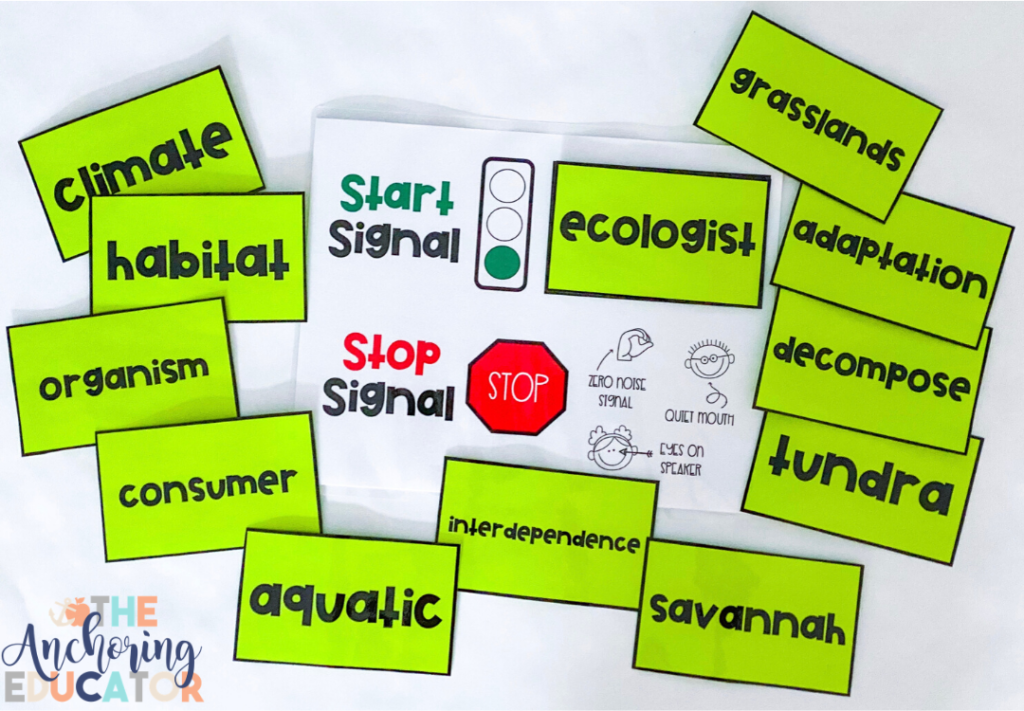This simple and effective strategy integrates academic vocabulary with classroom management! Let’s get real, the key to success in every classroom is having solid classroom management. You can have the most amazing lessons, but if your students are all over the place they probably aren’t benefiting in the way you’d like. This classroom management strategy is so simple. Although it is technically two separate strategies, I recommend combining them and treating them as one. It consists of a clear start, or go, signal that communicates to students that it’s time to get to work and a clear stop, or attention, signal that brings them back as a whole class. Use these signals consistently and you will see magic happen in your classroom.
Distinct Start, or Go, Signal
BeGLAD, a professional development organization, uses a high-level signal word as a “go” word. The purpose behind choosing a high-level vocabulary word is so students have ample opportunities to acquire the language. Many students struggle with pronouncing high-level vocabulary, let alone reading it, learning the definition and then using it when speaking and writing. This process gives students an opportunity to practice that language. Think every time in a single day you give directions! This is such a bonus!
Steps to Choosing a Signal Word:
- Choose a high level vocabulary word from your unit of study. Choose a new word each day.
- Introduce the word to your students and have them say it with you.
- Later in the day, you can introduce the definition and add a gesture to help with remembering the definition.
- Give students your directions, then give them the signal word. Each time you give the signal word, students say it and do it {the gesture} with you.
- I do not repeat directions after the signal word is given. This is rough at the beginning but trust the process. Students will begin to listen to directions the first time. They will become more attentive listeners and your sanity will be saved.
Example of Signal Word Dialogue
“Our signal word today is decomposer. Say it with me, decomposer.
{After expectations/lessons are modeled} When I give you the signal word, you will meet with your teams and begin working through the text on your assigned decomposer. Then, you will collaborate on a poster and tomorrow we will present it. The text and poster paper are on the back table. The signal word is decomposer. Say it with me, decomposer. Students begin moving and go to work.
{later in the day}
“Earlier today, we learned that a decomposer is defined as an organism that breaks down other dead or decaying organisms (add a gesture with the definition that will help students remember the definition). Say it and do it with me, decomposer, an organism that breaks down other dead or decaying organisms (+gesture).”
“When I give you the signal word, you will line up for lunch. Say it and do it with me, decomposer, an organism that breaks down other dead or decaying organisms (+gesture).” Students then begin to line up.


Distinct Stop, or Attention, Signal
BeGLAD uses a distinct stop signal, which is a zero in American Sign Language. This represents zero noise. You can use this or any quiet signal you or your school site is already using. For example, quiet coyote or the peace sign would work in the same way. When giving this signal, make sure you are modeling the expectations you have of students. If you do not want them walking around, shuffling papers or talking when the quiet signal is up, then model that behavior. It’s a lot easier said than done. Many times we find ourselves giving the quiet signal, but then asking students to put something away or shuffling papers around.
Click here to download a FREE, editable template to support implementation. I hope you LOVE this simple classroom management strategy. It was a game-changer for me! Let me know if you have any questions in the comments below.
——————————————————————————————————–
Love this strategy? Check out some other strategies you will love!
